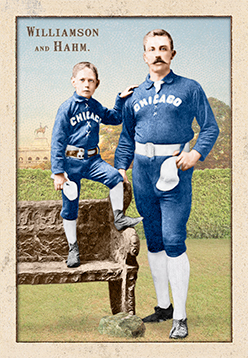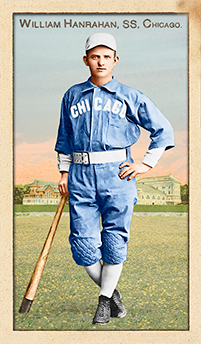- Series: Beginnings: 1880's
- City: Chicago
- Team: White Stockings
- League: National League
Charles Ruley Brynan (1863-1925) had two cups of coffee with major league clubs separated by three years. He was primarily a minor-league, right-handed pitcher with quick looks by two National League teams: the Chicago White Stockings in 1888 and the Boston Beaneaters in 1891. Along the way “Tod” played with two Southern Association teams in ‘86, the Nashville Americans and Memphis Grays followed the next year with the Duluth Freezers. In ‘88 Brynan played for the Minneapolis Millers and St Paul Apostles before getting a late-season chance with Chicago where he was 2-1 with a high 6.48 ERA. He fared worse with Boston, failing to get out of the first inning after giving up six.
- The remainder of his service had been with the Milwaukee Brewers, Des Moines Prohibitionists and Grand Rapids of the Michigan State League in 1889
- Brynan’s career mark in the minors was 31-39 with a 3.00 ERA

- Series: 1880s: Diamond Duos
- City: Chicago
- Team: White Stockings
- League: National League
Ned Williamson:
Edward Nagle Williamson (1857-1894). A 3rd baseman & shortstop for 3 teams over 13 seasons, Ned was an above average hitter & excellent defender (despite his portly physique). Ned held the single season HR record (27 in ’84) until topped by Ruth’s 29 in ’19. Ned’s career was shortened by a knee injury he sustained while participating in Al Spalding’s baseball world tour.
In 1894, the Reach Guide convened a panel of 11 former ballplayers, including HOFer Jim O'Rourke, to debate who was the greatest baseball player of all time. The panel concluded that the honor belonged to Ned Williamson. Cap Anson himself called Ned "the greatest all-around ballplayer the country ever saw."
- Won 5 NL pennants
- Played in two World Series
- Once owned single season doubles record: 49
Willie Hahm:
Willie Hahm, also known as “Master Willies,” was a rarity among early baseball mascots. He was white. The youngster, said to have been barely able to talk when first brought to the dugout, was the diminutive talisman for the Chicago White Stockings in the mid-1880s. “The Chicagos have great confidence in him as a promoter of success and make a great fuss over him” said Louisville Colonels manager Jim Hart in one of the earliest interviews explicating the curious role of mascots in America’s game. After triumphing in the 1884 campaign, Hart said the Sox had paraded Hahm at the head of their procession in an open landau. The Chicago Tribune reported on a big match with the rival Wolverines on June 18, 1886. Al Spalding brought a trainload of boosters to Detroit in hopes of preventing the eclipse of Chicago’s record home winning streak. Downtown Motor City was treated to the spectacle of the White Stockings and 200 rabid fans marching from the depot to the Russell Hotel carrying broomsticks with Willie Hahm leading the throng. Later, per the Tribune, “The Chicagos were escorted to the ground by a band, and entered the field behind little Willie Hahm, who carried an immense broom on which were written the words Our Mascot.”
- Many of the early mascots were black kids dragooned by superstitious players such as NY’s Buck Ewing
Artist's Note:
- The uniform colors on this card were changed in April, 2017 from black to blue to reflect recent reliable research by Craig Brown & friends at Threads of Our Game. Two cards were previously released featuring black uniforms.
Auction History
Cartophilia
Old Judge Pose: 502-7

- Series: Beginnings: 1880's
- City: Chicago
- Team: White Stockings
- League: National League
Charles Wellington Sprague (1864-1912) pitched for nine teams from 1887 through 1891, three of which were in the major leagues: the National League’s Chicago White Stockings and Cleveland Spiders, and the Toledo Maumees of the American Association. His other experience was primarily in the Western Association with Jamestown of the New York-Pennsylvania League being his final stop. With the big clubs, Sprague had a respectable 10-7 record during three seasons with a 4.51 ERA. The lefty played a little outfield when not on the mound. For Toledo, Charlie was the fourth starter with Egyptian Healy being the ace. The team finished fourth in 1890, the year so many stars bolted to their start-up “Players’ National League of Professional Base Ball Clubs” (aka the Players’ League or “Brotherhood.”)
- The Goodwin guide editors note that Charlie’s Old Judge images are unusual in depicting him in two different team uniforms in the same season: Chicago’s White Stockings and Maroons in 1888

- Series: Beginnings: 1880's
- City: Chicago
- Team: White Stockings
- League: National League
William T. Hanrahan, nicknamed “Red,” played minor league ball from 1885 through 1898, primarily in the Western Association and the Eastern League. He began with Albany of the New York State League but moved west to Chicago in 1888, presumably to make his bid to play major league baseball in the National League.
The shortstop was photographed by Old Judge that year in a Chicago White Stockings uniform. However, Red never played for the team and is identified by Goodwin instead as a member of the Chicago Maroons in 1888 and the Minneapolis Millers in 1889. This makes Red one of a handful of Old Judge subjects who was lucky enough to be on a major league roster the day the Goodwin photographers showed up, but unlucky enough to be removed from the roster without ever having played a game for that or any other major league team. So close, Red! So close.
Red was a regular with both the Maroons and Millers, playing in over a hundred games for both clubs. The sketchy minor league stats don’t record every campaign, but he seems to have generally batted under .300, faring better in the 1890s when he returned east. He hit .307 with Albany in ‘93 and .306 with Rochester in ‘96. By then his plate appearances were in decline, getting into only 16 games with the Browns. Red’s final season brought his pro ball career full-circle as he wrapped it up with the Johnstown/Palmyra Mormans (aka Johnnies) of a newly reconstituted NY State League in 1898, which now included Pennsylvania teams.
- The Maroons and Millers were led by manager Moxie Hengel, the only two seasons he managed in pro ball. With Minneapolis, Moxie shared managerial duties with Sam Morton. It is said the two had a strange method, Hengel piloting the road games and Morton serving as the home field boss
- As a rule of thumb in the 1880s series, I always designate a player’s team as that for which he is uniformed in the photograph, even if he never played for the team.

- Series: Pioneer Portraits II: 1875-1899
- City: Chicago
- Team: White Stockings
- League: National League
Eliza G. Green Williams Brown Daggett (1851-1926) was hailed in her hometown in 1920 as “the woman who has made Attleboro famous.” As the first female in the Bay State to seek mayoral office, Eliza was, indeed, noteworthy. But it was her surreptitious labors for Al Spalding under her maiden name that earned her a place in the annals of baseball as well as politics.
Al Spalding's White Stockings (Cubs) had many a fractious player - “kickers” in the jargon of the day. Spalding needed someone to bring a sane, objective and expert eye to the task of recording for posterity the hits, errors and miscellanea of the club's performance; someone impervious to the importuning of players lobbying for favorable rulings from the scorekeeper. He found what he needed in a lady who lived across from the ballpark, a woman who was an avid fan and an inveterate record-keeper. Eliza scored every home game and she had the cool, detached manner of a secret agent. Spalding recruited her to be his anonymous official scorer and, for a decade (1882-91), Eliza sat with the players' wives, keeping meticulous score and passing judgement on hits and errors - even settling player arguments - but never betraying her professional role. The National League officials to whom Eliza dispatched her score cards never knew that “E.G. Green” was a woman, allowing Spalding to avoid the scandal that would have ensued had it been known that a woman held such an important job in the sports world of Nineteenth Century America.
- Eliza was able to avoid detection completely, even from club-omniscient captain Adrian Anson, despite the fact that Eliza usually performed her duties while sitting beside Anson's wife.
- Apparently, Eliza kept the secret even from her family. Her son Charles recounts that he would mail the scorecards to Major League Baseball for his mother, without ever knowing the contents or purpose of the packages.
- Daggett was a devoted suffragist, a friend of Susan B. Anthony, and a tireless campaigner for the Republican Party long before seeking office for herself
- Her son Charles Williams was team treasurer for the Cubs during their championship season of 1908




